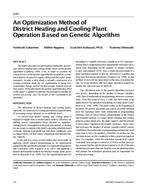Extreme weather events are expected to become more intense and more frequent, and lead to increases in heat-related mortality.Unfortunately, there is no set of agreed heat wave time series to test new buildings or complete building stocks against. In this work, weattempt to solve this by finding analytical relationships between heat waves and increases in internal temperature for 25 monitoreddwellings. The result is a methodology that allows the forecasting of the effect of extreme events on buildings with almost no computationaleffort. Extrapolating the results to the whole UK domestic stock indicates that, for example, a heat wave of three days with a maximumamplitude of 5 kelvin above the situation prior to the heat wave will result on an increment in internal temperature of 1.5 kelvin or morefor 43.3% of dwellings and a rise of 2 kelvin or more in 3.5% of the dwellings by the third day of the heat wave.
Citation: 2017 Annual Conference, Long Beach, CA, Conference Papers
Product Details
- Published:
- 2017
- Number of Pages:
- 8
- Units of Measure:
- Dual
- File Size:
- 1 file , 1.2 MB
- Product Code(s):
- D-LB-17-C002


